Years ago, I saw a small tree coming up in the meadow, not far from the yard. Huh. Wonder what it is? Well, it was a persimmon, and that being one of my very favorite trees, I decreed that it should not be mowed. It grew quickly, quickly enough that an orchard oriole pair tried nesting in it in the summer of 2021, how wonderful!
And now, it would find a new use.
The persimmon branches I cut and put in a vase for my now captive hickory horned devil did something unexpected, wilting dramatically overnight. Some plants just do that, especially woody plants. Oh no! I couldn't feed my Precious dry, dying/dead leaves. What to do? Well, I got online in the wee hours and searched and searched for sleeves to put on live trees, before I realized I had an answer right in front of me. I'd just take the mesh clothes basket and zip it right onto the living tree! Brilliant! or so I thought at the time. It's never as brilliant as it seems.
Walmart to the rescue! I'd been meaning to buy one of these groovy clothes baskets (as opposed to hampers) for awhile, to house little things like insects and small birds. It would be a good hummingbird home, for instance...maybe even a good bat home, a good nestling home...I like it.
The beauty being that it has great big windows AND it zips completely closed.
I would let the persimmon tree do all the work of keeping its leaves alive and juicy, and just zip the Worm inside, on a living branch full of leaves!
I ran the branch in one window and zipped it closed with the worm inside on August 23.
Pretty slick, huh? I twist-tied it in place by its various straps. That thing wasn't going anywhere.
Just to make sure, I twist-tied the zippers closed. However.
I woke up in the wee hours the next morning, as I am wont to do, thinking...is that mesh small enough to keep braconid wasps out? I knew it would keep cuckoos out, and big old tachinid flies, which lay eggs on caterpillars, but parasitic wasps? I asked my guru for all things insect, Laura Stalder Hughes. Nope, she said. Braconids can definitely get through that mesh. ARRRGH. Back to the drawing board.
I must diverge for a bit, to explain why I woke up thinking about braconids. Here are some images from my blog from 2010, showing a glorious tobacco hornworm Manduca sexta decimating a tomato plant.
The adult of this impressive worm is the Carolina sphinx, shown here on large-flowered evening primrose Oenothera glazioviana, in my garden.
Those flowers are more than 4" across. The Carolina sphinx moths are so big you can hear and feel them fly in. They have a low thrum like a hummingbird. They are miracles on wings.
And this is why you should not squish or toss or otherwise torment the hornworms on your tomatoes. Find a "victim" tomato plant (everybody has one) and put them on it. Please. Let them live. They are getting rare, at least around here. I get very excited when I get one on a tomato plant, but they rarely make it to adulthood, thanks to birds and braconids.
To show you how long ago that lovely caterpillar encounter was...here are Liam, Grady and Arlo, all of whom are either graduated from or in college now, inspecting the worm. Liam's gonna love this picture...
And this is what braconid wasps do to large caterpillars.
The little braconid female lays her eggs on the caterpillar. The eggs hatch, and the tiny larvae burrow through the skin and eat the caterpillar from the inside out. They avoid eating vital organs until they are ready to pupate and exit the decimated husk of what was once a turgid, healthy caterpillar. As a final thank-you, they eat the circulatory and digestive organs. Bye, thanks for giving us your life. We'll be leaving now.
You can see the tops of the cocoons flipped off, as the adult wasp exited each one. The braconid might be called the gardener's friend, unless the gardener loves tobacco hornworms and giant sphinxes as I do.
Here's a braconid cocoon mass I found Sept. 11 '22. There may or may not be the husk of a caterpillar under all that.
You see, these are the nightmares of a naturalist who is trying to do her best by one charismatic caterpillar. These are the things that keep us up at night.
So on the advice of Tami Gingrich, a legendary Geauga Co. Ohio naturalist, I went online and ordered a giant mesh sleeve from
raisingbutterflies.org
the biggest one they make. Its polyester mesh is too small to admit braconids. Hooray!
And I kept the caterpillar in the hamper on the live persimmon branch because I had no choice but to do that until the sleeve arrived. And I am happy to say that no braconids had gotten in to parasitize it before it came in the mail.
Meanwhile, the little brown caterpillar was about to go through some serious changes. It was growing but it wasn't eating. It hadn't eaten a bite since I took it in on Aug. 23. Here it is on Aug. 24. Of course I was blaming myself and the wilty persimmon leaves, but something else was clearly going on.
At 11:11 AM on Aug. 24, this is how it presented:
Just hanging there, bent double, anorexic...arrgh! I was in turmoil because I had to take Curtis to the vet to get a bunch of stitches out. He'd had two tumors removed, both of them benign, thankfully. And this caterpillar was going to shed its skin, I was pretty sure.
Wouldn't you know that I'd have to be gone for the last instar skin shed of the most special caterpillar I had ever found? Oh how I wanted to see it, and make a timelapse, but Mr. Loew was more important than that!
He had been a Very Good Boy and not scratched his incision but maybe once in two weeks, and he needed to get his Frankenstein staples out, and get his good lab report, so off we went, hoping to see a brand new caterpiggle on our return.





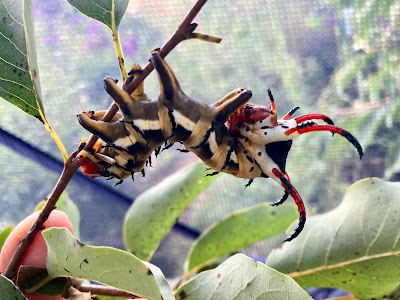

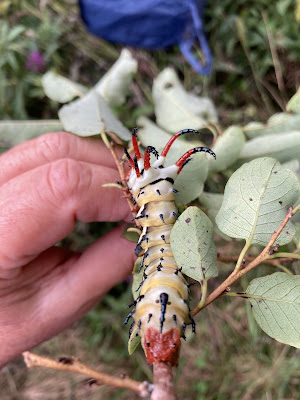















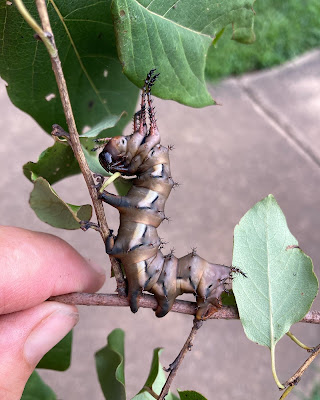


















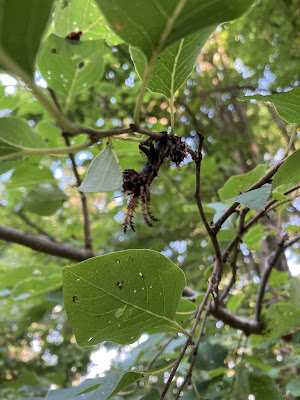

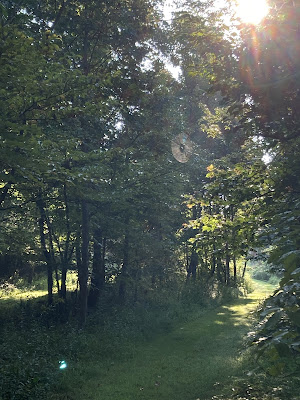










Tuesday, September 20, 2022
6 comments